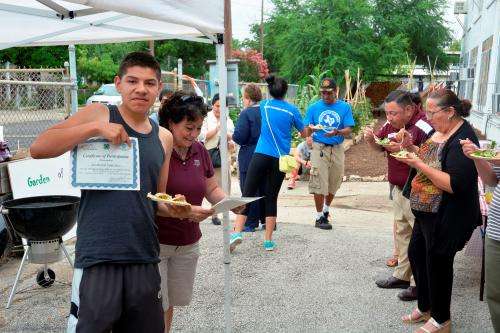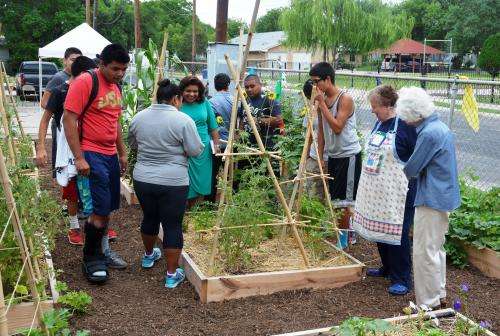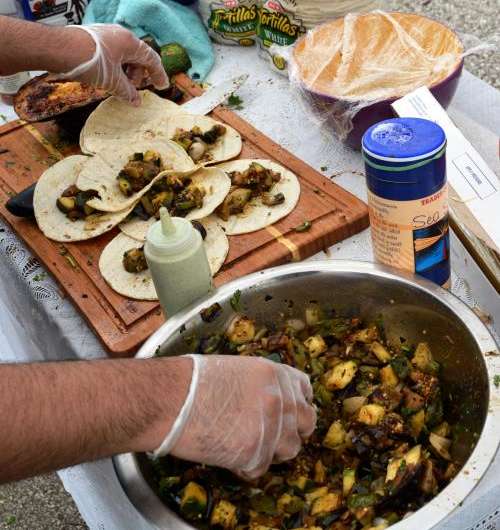Urban food desert pilot project an 'oasis' for at-risk youth

An urban food desert pilot project in the nation's seventh-largest city is teaching young people how to create a food "oasis" in their community, while learning important life skills, said a Texas A&M AgriLife Extension Service expert.
"An urban food desert is an area where affordable and nutritious food is difficult to obtain," said Rosemary Fuentes, AgriLife Extension health and wellness program specialist for Bexar County. "These are typically in low-income areas where there are few or no supermarkets and there is limited access to transportation."
Since February, AgriLife Extension has been spearheading the pilot effort that is now a five-year U.S. Department of Agriculture-funded community-based project to address the issue of urban food desert areas in San Antonio and to provide youth in those communities with new experiences and opportunities.
"We reached out to potential community partners in San Antonio and Bexar County," she said. "We found a number of partners and together we planned and began to implement project activities."
Fuentes said one of the project's main goals was to "address the lack of experience that, along with a lack of education, exacerbates poverty among at-risk youth."
"Through this program, we wanted to give young people practical service-learning experiences, engage them in developing useful life skills and introduce them to professional agricultural career opportunities. We also wanted to encourage them to continue school and strive toward a college education."
One of the first community partners in the countywide pilot initiative was the San Antonio Boys and Girls Club Teen Center adjacent to Christ the King Catholic Church on Perez Street on San Antonio's west side.
"We established a 4-H SPIN, or special interest, teen garden club and the participants gave it the name Garden of Greatness," Fuentes said. "We got permission from the church to use a plot of land behind the center to build and plant the garden. Then the club members and volunteers pitched in to make it happen."
Club members and personnel, along with AgriLife Extension, Bexar County Master Gardeners and other community volunteers, built 15 raised beds – 10 4-by-6-foot beds and five 1-by-6-foot beds. They planted corn, tomatoes, squash, peppers, beans and other vegetables, plus a variety of herbs.
"We had about 15 or 20 kids total involved in the garden project and about eight to 10 have been the core group that has stuck with the project from start to finish," Fuentes said.
Fuentes said other project collaborators included Christ the King Church, students and faculty from Texas A&M University at San Antonio, area community colleges, Bexar County Master Wellness Volunteers and the San Antonio Botanical Garden.
Two national minority student organizations—Minorities in Agriculture, Natural Resources and Related Sciences and the Society for Advancement of Hispanics/Chicanos and Native Americans in Science – also partnered in the project to help mentor, recruit and retain students in high school and college, Fuentes said.
"Plants were selected, maintained and harvested in accordance with the curricula from the Texas Go! Eat! Grow! and Junior Master Gardener programs, both AgriLife Extension initiatives," she said.
For months, teens from the center weeded, fertilized, watered and otherwise tended the garden.
"Most of the kids had never seen a garden much less been involved in building and planting one," said Lorena Navarro, assistant branch director for the Boys and Girls Club Teen Center. "It was exciting for them to watch seeds grow into plants and vegetables that could be eaten. We wanted them to take home what they've learned here and share it with their families."
"It's been great to see how excited and enthusiastic they have been about seeing the botanical garden and participating in these activities, especially building the garden and growing the vegetables," said Nadia Gaona, a Bexar County Master Gardener who helped initiate the garden project. "It's rare to see teenagers so anxious to go outside and get to work."
During the project period, Boys and Girls Club members were also given a tour of the San Antonio Botanical Garden. They also were visited by graduate students from Texas A&M University in College Station who showed them the scientific technique for extracting DNA from strawberries.
Participants were also involved in a scrapbooking project led by Dr. Melinda Garcia, who recently received her doctorate from our Lady of the Lake University. As part of this project, students took hundreds of photos of the various activities in which they were engaged.
"We wanted the kids to memorialize the garden and all the other project activities so they could remember everything they did and share these experiences with others," Garcia said.
The teens also learned about proper nutrition and food preparation by making healthy snacks in the club kitchen using recipes provided by nutrition experts, who also helped prepare the snacks.
Fuentes said the garden project and associated activities helped the teens develop a respect for nature, acquire useful interpersonal skills, apply practical aspects of science and math, and learn the importance of good nutrition and healthy eating habits.
"The experience helped these young people become a little more college-ready and gave them some good insights into career opportunities in nutrition, horticulture, agriculture and associated fields," she said.
Recently, a "harvest graduation" was held at the Garden of Greatness, in which the youth involved harvested their crops and received a certificate of appreciation for their participation.
Along with participating youth, attendees included AgriLife Extension personnel, Boys and Girls Club administrators, a representative for District 5 City Councilwoman Shirley Gonzales, Greg Garcia and Drs. Eric Lopez and Eva Lopez of Texas A&M University-San Antonio, Marisol Duncan, community service chair for the local chapter of the National Society of Leadership and Success, and Bexar County Master Gardener and Master Wellness volunteers.
Attendees were invited to speak and offered the young people their congratulations, along with some advice about the value of hard work, perseverance and education. Also during the event, local chef Grayson Michael Posey prepared and served attendees vegetarian tacos made from the produce harvested from the garden.
"I know about horticulture from my father and from personal experience, and I've enjoyed working with these kids to plant and grow their own crops," Duncan said. "I'm back in school now at Texas A&M University in San Antonio, but worked for more than 15 years in both Comal and Judson ISD in special education and ESL, so I enjoy teaching others. This garden project is a great way to help at-risk kids."
"I'm very proud of these young people and all they have accomplished," said Fuentes. "I like to say we're not only helping them plant seeds in a garden, but also helping them plant seeds for their future."

Recently, Fuentes learned the USDA awarded the Bexar County program and another AgriLife Extension food desert program in Harris County nearly $700,000 in grant money to be shared between the two projects over a five-year period.
Fuentes has been reaching out to other potential community partners, including those in area government, academia, business, youth service agencies and the food service industry, to join in the project. She is also working to develop a means for participants to have access to scholarships for higher education.
"We're especially interested in the academic aspect of this program to carry things into the future," Fuentes said. "I can envision a scenario where we have a 14- or 15-year-old who participates in the project, then becomes interested in horticulture, nutrition or some other related field. This person then gets a scholarship, goes to Texas A&M, graduates and comes back to share his or her knowledge and get others involved, thereby benefitting the entire community."
"This is the first step in reaching youth who have traditionally been hard to reach with the intent of exposing them to careers in food, agriculture, nutrition and the conservation of natural resources, especially in urban areas," said Manuel Piña Jr., associate professor in the agricultural leadership, education and communications department at Texas A&M's College of Agriculture and Life Sciences, College Station.
"We feel the best way to expose these young people to these opportunities is to provide them hands-on experiences under the guidance of AgriLife Extension mentors. We hope this will lead to the more long-term goal of inspiring them to go to college and become professionals in one of these career fields."
Piña said coordinators hope to expand the college-readiness aspect of the project by involving more undergraduate and graduate college students in future activities.

"They can provide the teens with practical guidance and information on things like academic requirements for admission, courses they would have to take for their major, and how to obtain financial aid," he said.
Piña said project coordinators have also begun discussions with organizations and businesses they feel will have an interest in helping support the program, possibly through funding scholarships for some of the participants.
"We have a unique opportunity to explore new and innovative ways to provide insight, experiences and mentoring to improve the number of minority AgriLife Extension county agents," said Darrell Dromgoole, associate department head for AgriLife Extension partnerships and engagement and principal investigator for the newly-funded project. "This is only the beginning. Next we will be searching for more funding opportunities, internships and scholarships, while at the same time making every effort to adopt or adapt this effort to other urban counties across the state."
"This project exemplifies what can be accomplished when individuals and organizations within a community come together in a common purpose," said Dr. Doug Steele, AgriLife Extension director, College Station. "Becoming involved to promote positive change is needed to address many critical issues we face today.
"While urban food deserts exist in all metropolitan areas of Texas and throughout the U.S., this project provides an innovative and engaging approach to not only help improve access to healthful, nutritious foods, but also to provide at-risk youth in those communities with the knowledge, hands-on experiential learning and life skills needed to help them build a better future."
Provided by Texas A&M University


















